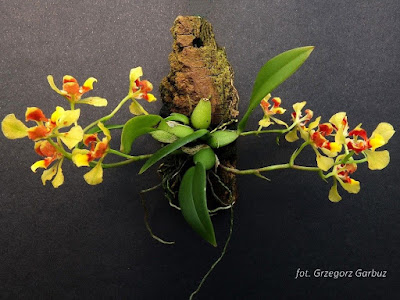Oncidium coloratum is native to Brazil. This orchid was discovered in the state of Espírito Santo. It grew at the foot of the coastal mountains at an altitude of about 300 m above sea level...
Oncidium coloratum also called as The Colored Oncidium, Baptistonia colorata, Carria colorata, Carriella colorata, Gomesa colorata, is a species of the genus Oncidium. This species was described by Königer & J.G.Weinm.bis in 1994.
IDENTIFY ONCIDIUM COLORATUM
Oncidium coloratum is native to Brazil. This orchid was discovered in the state of Espírito Santo. It grew at the foot of the coastal mountains at an altitude of about 300 m above sea level.
It is a miniature sized, warm to cool growing epiphyte with narrowly ovate, laterally compressed, up to 1.5 cm long and 0.7 cm wide pseudobulbs partially enveloped basally by 1 to 2 scarious bracts and carrying a single, apical, lanceolate to linear-lanceolate, leathery, acute, conduplicate, up to 4 cm long and 0.7 cm wide leaf below into the short, narrow, petiole-like base.
The Colored Oncidium blooms in the fall on an axillary, slender, terete, 4 cm long, ascending to spreading inflorescence arising on a mature pseudobulb and carrying 1 to 3 small, pubescent flowers. The flowers are small for this type, 1.5 cm in diameter, but large in relation to the whole plant and intensely colorful. The flakes of both whorls are yellow, but the inner whorl flakes have pronounced rust-red spots and small yellow spots on the tips. The ridge has rusty-red lateral plots, the middle plot has a white lower half, and the upper one is copper red with a yellow border. At the base of the lip is a light brown bead. The flakes of both whorls have a teaspoon shape and long narrow claws at the base, which expand to form rounded or sickle-shaped plaques.
ONCIDIUM COLORATUM CARE AND CULTURE
Cultural information should only be used as a guide, and should be to be adapted to suit you. Your physical location; where you grow your plants, how much time you have to devote to their care, and many other factors, will need to be taken into account. Only then can you decide on the cultural methods that best suit you and your plants.
Light:
Oncidium coloratum needs a light level of 15000-25000 lux.
Temperature:
The average temperature of the summer day is 29-30 ° C, and the summer night 19-21 ° C, which gives a daily difference of 9-10 ° C. The average temperature of the winter day is 24-25 ° C, and the night 14-15 ° C, giving a daily difference of 10-11 ° C.
Humidity:
The Colored Oncidium needs the humidity of 80-85% throughout the year.
Substrate, growing media and repotting:
You can use any loose substrate, but this species prefer to grow on rootstocks.
Watering:
Throughout the year, rainfall is moderate to heavy, but in winter it is a bit drier. The cultivated plants should be abundantly watered during the growing season, but the roots must dry very quickly after watering. In late autumn, the amount of water can be slightly reduced.
Fertilizer:
During the active growth, the plants should be fertilized every week 1/4-1/2 of the recommended dose of fertilizer for orchids.
Rest period:
Watering for Oncidium coloratum should be reduced in winter, but they can not remain dry for a longer period of time. Fertilization should be reduced or eliminated completely until regular watering is undertaken in the spring.















COMMENTS